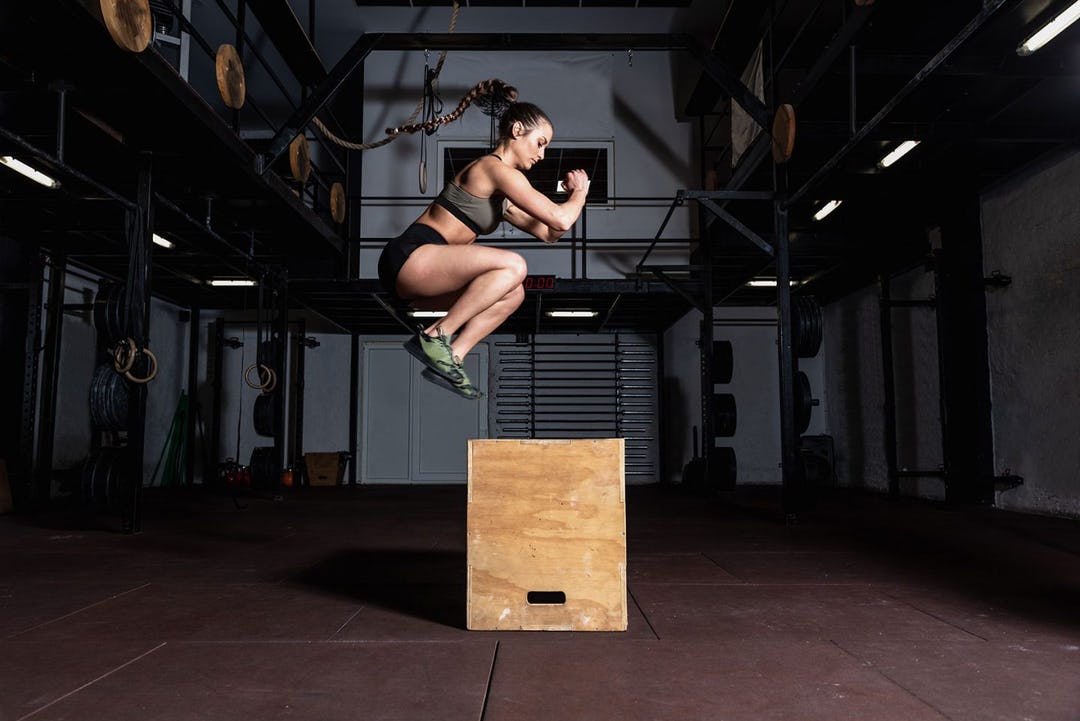The box jump is an exercise seen frequently among athletes, and even more often in YouTube gym fail compilation videos. It’s a great movement for developing power and a fun way to add a more athletic component to any strength workout, but most people misapply it in their training. There’s no denying that box jumps can spike the heart rate, but they were never intended to be done for conditioning, utilizing high reps and short rest periods. Let’s take a comprehensive walk-through of the box jump exercise, including the proper way to perform it, the training you need to improve it, and how to incorporate it effectively—and safely—to build total-body explosiveness.
What Is A Box Jump?
While the exercise does clearly involve jumping from the floor onto a box, it’s not quite as simple as it seems. Not any box will do, and the object isn’t just to get up on top of the surface by any means necessary.
The box jump is a low-level plyometric exercise. That is, it trains the muscles’ stretch reflex to develop explosive power. You quickly lower your body into a half-squat to stretch the glutes and hamstrings, and then use the resulting release of elastic energy to help power you up in the air. So as not to come down too hard, the box is there to break your fall, but it also teaches you to land like a cat—decelerating your body mass and absorbing the force of your jump. These skills are highly valuable to athletes who jump and sprint, so the box jump is a staple in many sports training programs.
At the same time, because it’s not particularly complex or dangerous to perform (if done as intended), the box jump can be done by recreational gym rats who want to add a bit of power training to their routines.
The boxes used can vary in height from a few inches to a few feet, and can be constructed of hard wood, rubber, firm padding, and even steel. Whichever kind you have access to, make sure you start with one that’s not too high (more about this below) and offers a stable surface for your feet to land on—and an even base that doesn’t wobble. Some boxes have fairly small foot surfaces, so, in general, the wider or larger the platform you have to jump on to, the better. (You’ll have less chance of missing it!)
How To Do The Box Jump
Before we get into how to execute the jump correctly, let’s go over a few ground rules for safe box jumping. You’ll also want to check out the five progressions for building up to a box jump from Onnit Director of Fitness Education Shane Heins, beginning at 1:03 in the video above.
Use A Moderate-Sized Box
First of all, be conservative with the height you choose. You should warm up on boxes that are very low to the ground—just a few inches to a foot or so high—and do your work sets with a box that’s only around knee height. Twenty-four to 30 inches high is plenty for all but the most experienced jumpers. Yes, we know you see people jumping onto 50-inch boxes and higher on YouTube and Instagram, but believe it or not, most of them are just trying to impress you, and they aren’t using good form.
The depth you squat to in your takeoff and your landing should be almost the same. That is, you should be landing in approximately a half-squat position, or where your knees are bent about 45 degrees. If you land so deep that your knees are practically to your chest and your lower back is rounded, the box is much too high!
Think about it like this: the point is to build athletic power. If you’re a football player exploding off the line of scrimmage, would you start in the bottom of a squat? Do you bend your knees 90 degrees to take a jump shot in basketball? Do sprinters curl up into a ball before they take off down the track at the sound of a starter’s pistol? Of course not. The goal of a box jump isn’t to leap as high as possible—it’s to train the mechanics that let you develop power when it counts.
Stand Far Enough Back
It matters how far away from the box you set up. Stand back a few feet and extend your arms so that your fingertips touch the box when you reach forward with both hands. That represents the distance that should exist between you and the box when you’re about to perform your first rep, so make a note of it and stand in that spot when you begin your set. Respecting this space ensures you won’t catch your fingers on the box during your upswing when you propel yourself upward into the air. It’s also a good distance to prevent you from overjumping your target and tipping the box forward when you land.

Swing Your Arms Up
Speaking of upswing, understand how much your arms contribute to your jumping momentum. Your arms should swing down by your sides as you descend into the half-squat—the mechanics are somewhat like compressing a spring—and then swing upward with force as you jump. Many people do the opposite, driving their arms down toward the floor as they extend their hips and legs. While this may make you look like a human rocket ship, it’s utterly pointless in jump training, as it does not transfer forces from the floor and through your body to facilitate height.
Land With Control
You know the old saying, “What goes up must come down,” so we have to talk about how to land. Your landing should be quiet and soft. Coming down like a ton of bricks puts a lot of stress on the joints of the lower body and can cause injury. Also, as mentioned above, one of the benefits of a good box jump is learning to slow the force of your movement down, so try to stick your landings like a gymnast. If you find that you’re landing hard and loudly, guess what? The box is probably too high.
Step Down From The Box
Lastly, don’t jump off the box to return to the floor between reps. STEP down off it. Jumping down is the most common box jump technique mistake, and it’s a dangerous one. There’s no benefit to jumping backward off a box, and even at fairly low heights, it can injure your Achilles tendons. (Yes, advanced athletes sometimes jump backward to dismount the box, but we don’t recommend it for folks reading this article.) Set a smaller box, bench, or step next to the box you’re jumping onto and use it as a staircase to get down (if the box you’re jumping on is too high to comfortably step down from directly).
With all these caveats and details out of the way, here’s a step-by-step guide to performing the box jump movement.
Step 1. Set a box on the floor that’s roughly knee height. It should be high enough to provide some challenge but not so high that you can’t land safely. Twenty-four to 30 inches should do it. Extend your arms straight in front of you and stand at a distance that allows your fingertips to touch the edge of the box.
Step 2. Stand with your feet about hip-width apart. (If you deadlift, your deadlifting stance should be about right.) Quickly dip your hips, bend your knees, and swing your arms back to gather power.
Step 3. As soon as you feel your body drop into a half-squat position, explode upward, extending your hips and knees and throwing your arms up and forward to jump off the floor.
Step 4. Land softly in the middle of the box with both feet at the same time. Step down from the box carefully and take a moment to set up for the next jump.
What Muscles Are Used In A Box Jump?

The box jump is a major compound movement that requires a transfer of energy through the entire body, so you can pretty much point to an anatomy chart at random and land on a muscle that’s involved in the exercise in some way. Of course, the quads, hamstrings, and glutes are the prime movers, creating the hip and knee extension that lifts you off the floor, and your shoulders work to drive the upswing of your arms, which helps to propel you upward.
However, because you don’t load the body like you do in a squat, deadlift, or other resistance exercise, you probably won’t feel sore in these muscles the next day, and you won’t see size gains in them from jumping alone. The box jump doesn’t create a great deal of muscular tension, or maintain that tension for a length of time, so it’s not going to build bigger muscles. Using it in place of a leg exercise for muscle mass is not a good idea.
You may be surprised, however, to find that your deep abdominal and oblique muscles are in fact sore a day or so later. That’s indicative of how involved your core is in transmitting forces to your arms for the takeoff. Remember that the goal of box jumping is power, and the result is a highly trained chain of faster, more explosive muscles that work together as a unit.
Best Box Jumping Exercises
Most of the time, you should practice box jumps with a 24–30-inch high box, using the technique described above. Three to five sets of three to five reps is a good general prescription for power gains, but end each set the moment you feel yourself slowing down or losing control of your landing.
Occasionally, to test yourself, you can use a higher box and attempt bigger jumps that might cause you to land deeper than a half-squat. In this case, you can work up to sets of three, two, or just one all-out jump. But for safety’s sake, do this sparingly, and have a spotter handy in case you stumble on the box. One to three times a week is enough frequency for box jumps.
Please be cautious. Unlike with strength training, where you need to add weight or reps on a semi-regular basis to keep making gains, progressing jump training isn’t so linear. Most athletes don’t need more than a moderate-height box, so don’t think that because you leapt up onto a 24-inch box last week, you need to use a 25-inch one this week. If you get to the point where box jumps feel easy at a certain height, work on jumping higher and landing on the same-size box before you bother to increase the elevation. Then, as explained, you can sporadically test your training by attempting higher boxes.
If you’ve done CrossFit WODs or attended a HIIT (high-intensity interval training) exercise class, you might have been instructed to do box jumps as part of a circuit or conditioning drill, using high reps and short rest periods. We suggest that you don’t train like this with box jumps. Explosive exercises and high repetitions don’t mix. That is, power movements like the box jump must be done for lower reps to prevent your form from breaking down due to fatigue. And you simply can’t generate the same explosiveness on a 10th jump as you can on the first three of a set, so high reps don’t suit the goal. Box jumps should also be done with longer rest periods for this same reason—two minutes or more between sets.
If you want to get an endurance boost from your training, you can get it with any number of other, safer exercises. That said, if you’re determined to mix power and conditioning in the same session, we have a safe plan to do so below under HIIT Box Jump Workout.
The earlier in your workout that you do box jumps, the more power and height you’ll be capable of getting. But realize that the box jump does cause some impact on your joints. You also shouldn’t do any kind of fast movement without thoroughly warming up your muscles first, and even a great mobility routine done at the start of your workout may not be enough. Therefore, we suggest placing box jumps toward the beginning of your session, so you’re fairly fresh when you do them, but not cold. For instance, you might do them as your second or third exercise, after a few sets of hamstring and glute work. Leg curls, hip thrusts, or glute-ham raises will pump blood into the posterior chain (the muscles on the back side of the body) and lubricate the hips and knees.
There are other exercises you can do to that sometimes don’t require a box, or even a jump, but will support your box jump training and improve your overall jumping ability. By choosing movements that train the upper body to generate upward force, or that strengthen the posterior chain, you can tighten up the component mechanics that make for gravity-defying leaps.
Weighted Jump With Kettlebell
See the video above at 0:25
Step 1. Place a kettlebell on the floor and stand with feet hip-width apart. Get into a half-squat, as if you were winding up for the box jump—you should be able to reach the kettlebell handle from that position. If the weight is too low, elevate it by resting it on a weight plate or mat. Now deadlift the kettlebell so you’re standing tall.
Step 2. Quickly dip your hips and knees as if jumping, lowering the kettlebell to just above the floor (don’t let it smack into the platform you created), and then explode up. Don’t worry about jumping high, just focus on the power of your explosion. Your feet may rise off the floor, but it’s OK if they don’t. Land softly, reset, and repeat. Do 3 sets of 3–6 reps.
Weighted Stepup
See the video at 1:22
The stepup can help familiarize you with the use of a box while building the glutes, hams, and quads. You can do it with dumbbells, kettlebells, a barbell across the back of the shoulders, or a weighted vest.
Step 1. Hold onto your weight and place your foot on a box or bench. It should be high enough so that your thigh is about parallel to the floor when the foot is resting on it.
Step 2. Drive through your heel to step up onto the bench without letting your rear leg rest on it—let it dangle behind you. Step back down, starting with the trailing leg. Do 3 sets of 8–12 reps.
Push Press
See the video at 1:45
Doable with a barbell, kettlebells, or dumbbells, a push press is just an overhead press that uses the legs for assistance. By dipping the knees, similar to how you move in a jump, and then driving up explosively, you can press more weight overhead, which makes the exercise effective for upper-body strength as well as generating power from the ground up. Push pressing is also a great way to learn to keep your body tight and braced. If any muscles are relaxed, you won’t be able to move the weight effectively.
Step 1. Hold the weight at shoulder level and stand with feet about hip width. Brace your core.
Step 2. Drop into a quarter-squat, initiating the descent by bending your knees. Keep your head, spine, and pelvis in line so your back is flat and your eyes and head are forward. You don’t want to turn this leg drive portion of the lift into a squat, so only bend your knees enough to get some momentum, and don’t hinge your hips too much. Imagine yourself doing the move against a wall and sliding your torso up and down it—you should be that upright.
Step 3. As soon as you’ve dipped, extend your hips and knees explosively to stand up straight, driving through your heels, and simultaneously press the weight straight overhead. You’ll need to push from your shoulders and triceps, but with a strong and quick leg drive, most of the power for the press should be provided by your lower body. Keep your core tight throughout the move so your spine is stable and safe. Lower the weight back to your shoulders, take a moment to reset, and then begin the next rep. Do 3 sets of 5–10 reps.
HIIT Box Jump Workout
We’ve established that box jumps should be used conservatively and for athletic performance, but we can’t deny that they spike the heart rate and involve almost every muscle in the body, so we understand if you’re tempted to use them in a conditioning workout that burns calories and boosts endurance.
A way to do this safely is to perform a low-rep EMOM, meaning that you set a timer and perform a set of jumps every minute on the minute. Find a fairly low box—low enough that you know you won’t have trouble landing on it even if you’re tired—and start the clock. Do three jumps, and then rest for the remainder of that minute. When the timer reaches 1:00, do another set. So let’s say the three jumps takes you 15 seconds to do; you’ll get 45 seconds to recover.
Continue this for 20 minutes. It may seem easy for the first five minutes or so, but those short rest periods will catch up with you. This kind of workout probably won’t do much for speed and power, but it can serve as cardio.
If you’re a recreational gym-goer who mainly trains for a better physique and functional strength, but you’d like to add another athletic component to your workouts, incorporating box jumps before your biggest lift of the day can help to prime your nervous system. This can improve your performance on lower-body compound exercises like the squat and deadlift by supporting the recruitment of your fast-twitch muscle fibers. A few sets of box jumps done prior to a big barbell lift won’t fatigue you for the heavy training, but it may allow you to lift heavier and with better form.
Another option is to combine box jumps with a barbell movement, doing the two back to back. This is called contrast training, and it’s a method research has shown can maximize power development in athletes.
In a contrast set, you might do deadlifts with 80% of your max for a set of five (you should have at least a rep or two left in you; don’t go to failure), and then take about 30 seconds rest—during which you can walk over to the box. Now do a set of three jumps at a challenging height. Rest three to five minutes, and repeat for three to four total sets. This is stressful training, so it should be your only exercise for the session, and you should only do contrast training for three weeks at a time.

)





